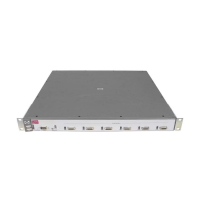Access Control Lists (ACLs) for the Series 3400cl and Series 6400cl Switches
Configuring and Assigning an ACL
Configuring and Assigning an ACL
ACL Feature Page
Configuring and Assigning a Numbered, Standard ACL 10-43
Configuring and Assigning a Numbered, Extended ACL 10-48
Configuring a Named ACL 10-54
Enabling or Disabling ACL Filtering 10-57
Overview
General Steps for Implementing ACLs
1. Configure at least one ACL. This creates and stores the ACL in the switch
configuration.
2. Assign an ACL. This applies the ACL to the inbound traffic on one or more
designated interfaces.
Caution Regarding Source routing is enabled by default on the switch and can be used to override
the Use of Source
ACLs. For this reason, if you are using ACLs to enhance network security, the
Routing
recommended action is to disable source routing on the switch. To do so,
execute no ip source-route.
Types of ACLs
■ Standard ACL: Uses only a packet’s source IP address as a criterion
for permitting or denying the packet. For a standard ACL ID, use either
a unique numeric string in the range of 1-99 or a unique name string
of up to 64 alphanumeric characters.
■ Extended ACL: Offers the following criteria as options for permit-
ting or denying a packet:
• Source IP address
• Destination IP address
• TCP or UDP criteria
For an extended ACL ID, use either a unique number in the range of 100-
199 or a unique name string of up to 64 alphanumeric characters.
10-35

